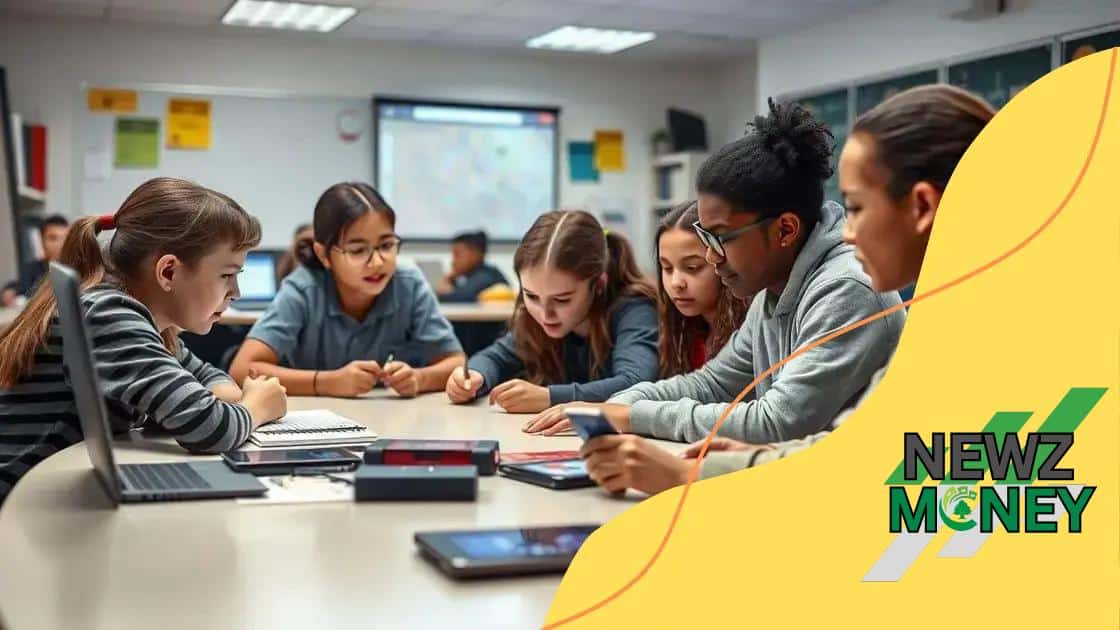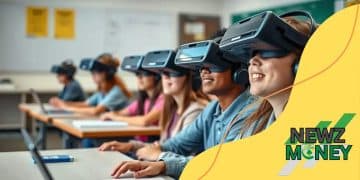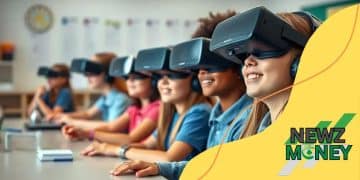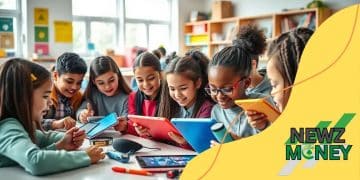Gamification in education: boost student engagement

Gamification in education enhances student engagement through interactive elements like points, badges, and challenges, making learning enjoyable and improving outcomes.
Gamification in education is changing how students interact with learning materials. Have you ever wondered how game mechanics can enhance student engagement? This article delves into its impact on modern education.
Understanding gamification in education
Understanding gamification in education is essential for modern teaching strategies. Gamification applies game design elements in non-game contexts, especially in learning environments. It aims to enhance student involvement and motivation through engaging methods.
Key Concepts of Gamification
At its core, gamification involves using points, badges, and leaderboards to create a game-like experience in educational settings. These elements make learning fun and competitive, encouraging students to actively participate.
- Points for completing tasks can motivate students to engage more.
- Badges reward achievements, giving a sense of accomplishment.
- Leaderboards introduce healthy competition among peers.
Many educators find that gamification changes the way students approach learning. It shifts the focus from traditional assessments to collaborative and exploratory experiences. For instance, rather than taking a standard test, a student might work on a project that allows them to earn points or badges. This approach provides immediate feedback and promotes perseverance.
Benefits of Gamification
The benefits are remarkable. Students enjoy learning more as they navigate through various tasks that feel like challenges. This method caters to different learning styles, helping students who may struggle in conventional settings.
- Increased engagement leads to better retention of information.
- Students develop critical thinking skills through interactive challenges.
- Gamification encourages teamwork and communication.
Ultimately, gamification reshapes education by creating a playful atmosphere where students feel free to explore and learn. Knowing how to implement these strategies effectively can transform classrooms into vibrant learning hubs.
Key benefits of gamification
There are several key benefits of gamification that educators and students can appreciate. By using game design elements in learning, we see remarkable improvements in student engagement and motivation.
Engagement and Motivation
One significant advantage is that gamification makes learning more engaging. Students are more willing to participate when they see learning as a game. They often feel excited to progress and earn rewards for their efforts.
- Engagement increases when tasks are fun and competitive.
- Motivation grows through instant feedback and rewards.
- Students may take more ownership of their learning journey.
This engagement can result in a more vibrant classroom atmosphere. When students are motivated, they are more willing to contribute and collaborate with their peers. This sense of community and teamwork enhances the learning experience.
Improved Learning Outcomes
Another benefit is the improvement in learning outcomes. Gamified elements encourage students to focus on the material and persist in their efforts. When challenges arise, gamification gives them an incentive to overcome obstacles.
- Learning becomes a process filled with goals and achievements.
- Students retain information better when they enjoy the process.
- Gamification helps develop problem-solving skills through interactive tasks.
Furthermore, by implementing gamification, teachers can tailor learning experiences to meet diverse student needs. This adaptability ensures that all students can participate and benefit from the gamified approach. Each student can progress at their own pace, fostering a sense of accomplishment.
Practical examples of gamification in the classroom

Implementing gamification in the classroom can take many forms that enhance the learning experience. Here are some practical examples that educators can use to engage their students effectively.
Interactive Quizzes and Games
One common way to gamify lessons is by using interactive quizzes. Platforms like Kahoot! allow teachers to create fun, competitive quizzes that students can answer in real-time using their devices. This method turns standard review sessions into exciting challenges.
- Students earn points for correct answers, increasing motivation.
- The immediate feedback helps reinforce knowledge.
- It fosters a competitive spirit that can enhance learning.
Additionally, educational games can be customized to fit various subjects. For example, teachers can develop board games that cover key concepts or use online platforms that allow students to explore subjects in a gamified format.
Badges and Rewards
Another effective strategy involves using badges and rewards. When students complete tasks or achieve specific goals, they can earn digital badges that recognize their accomplishments. This gamified approach helps keep students motivated and engaged.
- Badges can represent various skills, such as teamwork or creativity.
- Students collect badges, which promotes a sense of achievement.
- Using a leaderboard can encourage healthy competition among peers.
By implementing these elements, teachers create a dynamic environment that boosts engagement. The experience of earning rewards through gamification can make students more enthusiastic about their education.
Project-Based Learning with Game Elements
Teachers can also infuse game design into project-based learning. This method allows students to tackle real-world problems while incorporating game-like elements into their projects. Students might work in teams to develop solutions for local community issues or create presentations that earn them points.
Integrating gamification this way encourages collaboration and critical thinking. When students are engaged in meaningful projects that also feel like games, they are more likely to invest their time and energy into their education.
Challenges and solutions in gamification
Implementing gamification in education can bring both benefits and challenges. Educators often face obstacles when trying to integrate game elements into their teaching. Recognizing these challenges can help find effective solutions.
Common Challenges
One challenge is the lack of resources. Not all schools have access to technology or tools needed for gamified learning. This limitation can hinder the implementation of interactive activities.
- Students may experience frustration if resources are not adequate for gameplay.
- Teachers need to be creative with limited materials.
- Time constraints can impact planning and execution of gamified lessons.
Additionally, some teachers might resist adopting gamification. This resistance often comes from unfamiliarity with game-based learning strategies. It can be difficult for educators who have always taught in traditional ways to shift their approach.
Finding Solutions
One effective solution to these challenges is training and professional development. Schools can provide workshops to help teachers understand the benefits of gamification and how to implement it effectively. By sharing success stories and strategies, educators can feel more confident about using game elements.
- Building a supportive community among teachers encourages collaboration.
- Online resources and communities can offer ideas for low-budget gamification.
- Utilizing free online platforms for quizzes and games can be a great start.
Another solution is to pilot gamification on a smaller scale. Teachers can begin by incorporating a few game elements into existing lessons. This approach allows for gradual adjustment and gives both teachers and students time to adapt. By testing different methods, educators can see what works best in their unique setting.
By addressing these challenges proactively, schools can create more engaging learning experiences using gamification. Overcoming resistance and resource issues will lead to a richer educational environment for both students and teachers.
Future trends in educational gamification
The landscape of educational gamification is continually evolving. As technology advances, so do the methods of engaging students through gamified learning experiences. These trends promise to enhance how education is delivered.
Increased Use of Augmented Reality (AR)
One exciting trend is the integration of augmented reality in the classroom. AR can bring educational content to life by overlaying digital information onto the real world. This interactive way of learning can capture students’ attention and spark their imagination.
- AR can make complex concepts easier to understand.
- Students can experience simulations that enhance practical learning.
- This technology allows for immersive storytelling, making learning memorable.
For example, students studying history might explore a virtual reconstruction of ancient cities using AR tools, making lessons engaging and interactive.
Personalized Learning Experiences
Another trend is the move towards personalized learning experiences. With gamification, educators can tailor challenges and tasks to meet the individual needs of each student. By analyzing data from game interactions, teachers can customize pathways for students.
- Each learner can progress at their own pace, enhancing understanding.
- Gamified elements can adapt to accommodate different skill levels.
- This approach promotes student agency and self-directed learning.
As students play games that challenge their abilities, they feel a greater sense of ownership over their learning process, which can lead to improved outcomes.
Data Analytics in Gamification
Data analytics will also play a big role in the future of gamified education. Educators can track progress and engagement through various metrics. This information helps identify trends and areas where students may struggle.
Teachers can then adjust their strategies based on these insights, creating more effective gamified experiences. Utilizing data can ensure that no student is left behind.
The future of gamification in education is bright, incorporating technology and personalization to enhance learning experiences. As these trends develop, they will likely transform classrooms into more dynamic and engaging spaces.
FAQ – Frequently Asked Questions about Gamification in Education
What is gamification in education?
Gamification in education involves using game design elements to make learning more engaging and motivating for students.
How can gamification improve student engagement?
By introducing game-like elements such as points, badges, and challenges, students find learning more enjoyable and are more likely to participate actively.
What are some practical examples of gamification in the classroom?
Examples include interactive quizzes, badge systems for achievements, and project-based learning with game elements.
What future trends can we expect in educational gamification?
Future trends include increased use of augmented reality, personalized learning experiences, and data analytics to enhance gamified lessons.





